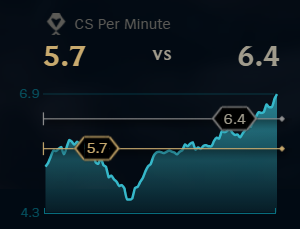Play to Improve, Not to Win
You’ll often hear the advice, “Play to improve, not to win.” What does that mean, exactly?

Improving at a competitive game like League of Legends can be a frustrating experience. One piece of commonly given advice is that players should “play to improve, not to win.” This is fair guidance, but it deserves a closer look beyond the surface level.
At first glance, the suggestion seems to be that focusing on wins and losses can be counterproductive. Since League’s matchmaking system is designed to maintain a roughly 50% win rate, you won’t win more games on average, even if you’re getting better. If you focus on your rank, you’ll get frustrated no matter your skill level. It’s best to ignore your rank as much as possible.
That’s helpful advice, but there’s more to unpack. It’s equally important to assess the other half of the guidance: disregarding wins and losses isn’t enough; you must track skills you’re strengthening.
Not playing to win doesn’t mean not caring about winning
Losing isn’t fun. When playing to improve, that doesn’t mean ignoring your win/loss record. You should still value winning but view it as a secondary metric of success. The primary way to gauge progress is by refocusing on refining specific skills.
Using Reiterate as a success goal
I’ve discussed using Reiterate’s goal-setting features before. You can feel a sense of accomplishment as you retire clips.
A solid system creating a “achieved” session where move clips there once you feel you’ve sufficiently internalized them. In your normal play, you should have most of your clips muted, so that you can focus on the 4 or 5 clips that would most benefit your gameplay. Your objective is to reach a point where you’re executing the skills in those clips without Reiterate’s prompting. When you’ve mastered a clip, archive it as evidence of your progress. As your archive grows, you’ll have concrete evidence of your improvement.
Using Acknowledgement as a success goal
Reiterate’s Acknowledgement feature provides scoring feedback. After each session, it reports your percentage of successfully acknowledged clips. I aim for 80% acknowledgement accuracy. When the session ends, I check my score, and if I’ve hit it I know I was focusing properly. No matter how the game goes, if I met that goal I know I had productive focus.
Riot’s statistics page
Did you know there’s a built-in statistics page in the Riot client? It was added a few years ago to little fanfare, and I think it’s been overlooked by a lot of people.

Here’s my farming statistics for this season. Lately I’ve been focusing on this and it’s nice to see it plotted as a graph over time, with the steady increase clearly showing. Steady increases clearly show progress, providing a sense of accomplishment. Tracking a metric like this offers an improvement-focused goal.
The user interface is a little obscure. To get a graph like this:
- Select the Profile tab in the client
- Click Stats.
- Select a champion from the list (it will show your three most-played champs).
- Set the dropdown menus to
Ranked Solo/Duo,Current Season, and your role (eg Jungle).
There are 15 different graphs it can show, grouped into three sections: Combat, Income, and Map Control. Click each of those to view the graphs in that section.
Find your motivation
Choose a goal that inspires persistence even through losing streaks. What would motivate you? Share in the comments!
